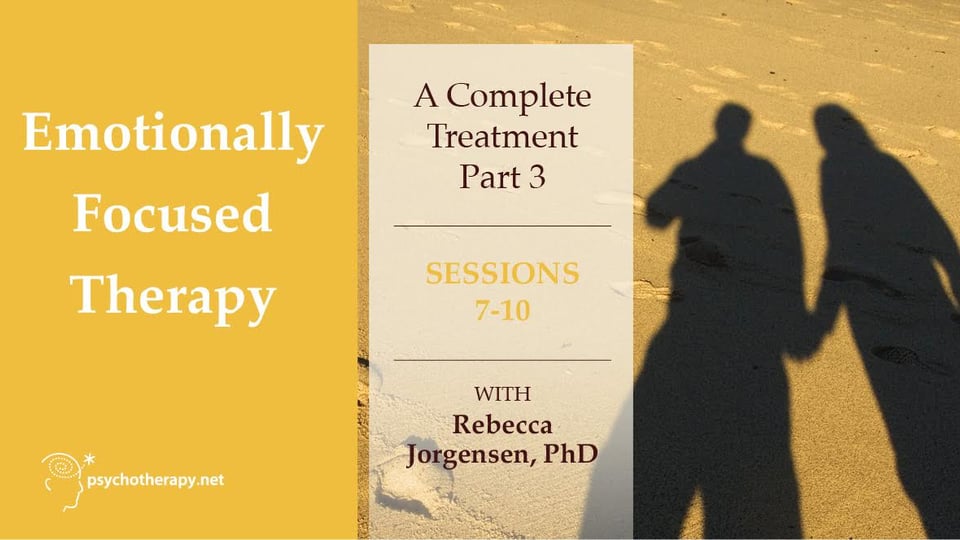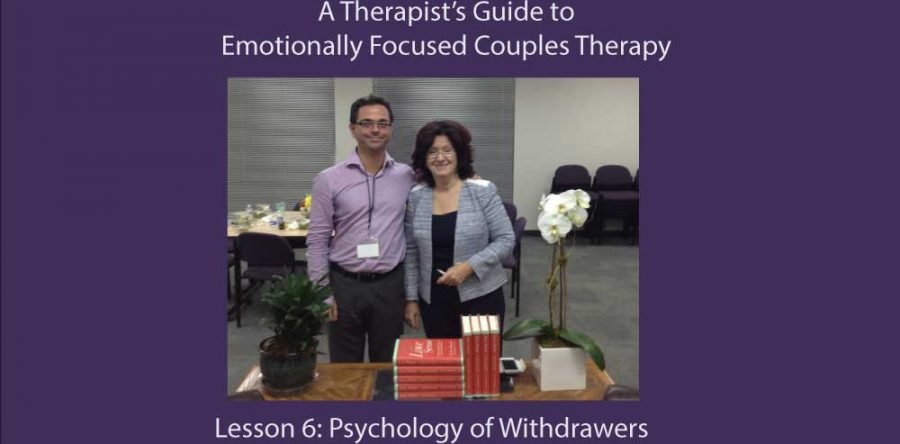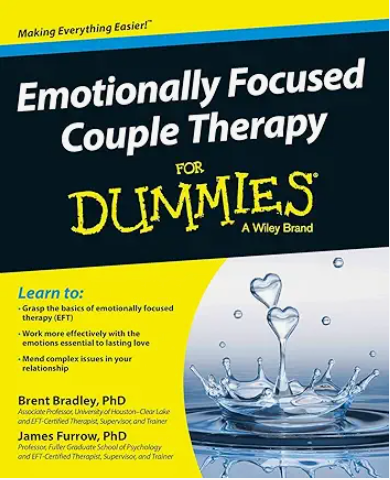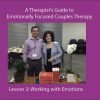LESSON 6: WHAT YOU WILL LEARN IN TODAY'S EFT LESSON...
> The main strategies a withdrawer uses to manage their feelings of inadequacy and fear of reprisal or arguments
> How to work with withdrawers in Stage 2 of EFT
> How to provide what the withdrawer needs to feel more comfortable being themselves in the relationship
The Psychology of Withdrawers:
Although it often seems from the outsider’s perspective that only the pursuer has concerns or fears about their attachment (and not the withdrawer who may present as calm or unperturbed) this is really not true. The difference is that the pursuer‘s attachment system responds to threats to their connection by becoming hyper-aroused, whereas the withdrawer’s attachment system responds by becoming hypo-aroused.
A hypoaroused attachment system functions by shutting down or numbing attachment needs and vulnerable emotions because it is not safe to feel them and because others cannot be counted on for support. Research has shown that hypoarousal and calmness are very different. A hypoaroused nervous system requires a lot of work and emotional effort to be maintained. It is a response to distress that is similar to playing dead or freezing up to avoid danger or minimize harm.
Strategies of the Withdrawer:
When as part of their hypoaroused state withdrawers are out of touch with their attachment/ dependency needs and their internal emotional reality, it is easy for them to perceive the problem of their relationship as a problem with the pursuer: If only the pursuer was not so needy, so irrational, or so over-reactive, everything would be fine...
The withdrawer who takes up this non-emotional and analytical posture often does not understand their own participation in creating the distress of their angry or dissatisfied partner and can frequently end up reinforcing the pursuers’ fears and shame-based beliefs that they are “crazy”, “needy”, or “too much to handle”. This then can lead to attempts by the pursuers to reform themselves, be on their best behaviors, or minimize their own needs which is bound to not be sustainable in the long-run, or may in the worst case lead the pursuer to disengage completely and begin to look more like another “withdrawer” (what is also called a burnt out pursuer).
Another frequently observed response in the withdrawer is to be in touch at some level with a fear of inadequacy or of being a disappointment. This can lead them to fend off criticism by reasoning with the pursuer to convince them that the pursuer really doesn’t have it that bad or to make the pursuer see how they are misinterpreting the withdrawer’s intentions, thus invalidating the factual basis of the pursuer’s perceptions.
Another behavior often emanating from this fear of being judged as a bad or unsuitable partner is to “go along to get along”, to placate, or to appease. In other words, if the withdrawer cannot manage to “make it all about the pursuer”, they often end up having to ward off shame and inadequacy feelings or fears of being left for lack of measuring up by trying their best to appease their partner even if it means saying or doing things just to keep their partner calm. The withdrawer who adopts this behavior often feels as if they have very little room to be themselves in the relationship. It is as if they have already given up on being accepted for their authentic selves and have concluded that they do not know how to please their partner and might as well therefore just try to say the right thing or keep their opinions to themselves.
Regardless of the actual behaviors they engage in, whether using logic and rationality as a weapon, externalizing blame, using problem-solving, placating/ appeasing, apologizing without really meaning it or knowing why, going along without fully being in it, or turning away, the main concern of the withdrawer is to keep the peace and keep the relationship and their partner stable. When the pursuer is happy or is not critical they breathe a sigh of relief and feel as if they and the relationship are “safe for now”. This also means that they are unlikely to bring up any issues pertaining to the relationship as they are careful not to disturb the temporary truce. They see conversations about the relationship as quickly escalating into a reminder that the pursuer is unhappy and that they - the withdrawer - are the source of this unhappiness. Better to let let sleeping dogs lie or not rock the boat is their main philosophy...
The Challenge for the Withdrawer:
For the therapist the main goal is to help the withdrawer come to take up more space in the relationship. This means both speaking their minds and feelings even if they may be different from their partner, and becoming more aware of their own emotions and experiences which they have gotten used to setting aside to not add fuel to the fire. The withdrawer must be helped to learn the lesson that it can be safe to express themselves and honestly say how they feel, state what they want and need, and allow themselves to depend on others for support and help. They must be helped to engage with their partner and their own emotional reality rather than withdraw and avoid the perceived dangers of putting themselves out there. In order for this to happen, they must have the experience that it is safe and good for them to stand up for themselves calmly and honestly instead of bottling their feelings or opinions up and only expressing themselves in bouts of anger when they have been pushed to the edge and finally lose it.
For a more comprehensive overview of the psychology of the withdrawer, read EFT trainer Brent Bradley’s chapter: Seeing through Withdrawing Eyes
Working with Withdrawers in Stage 1 and 2 of EFT:
In stage 1 of working with withdrawers, the main focus of the therapist’s work will entail helping the withdrawer not bypass their emotional and sensory reality (body) in their hurry to solve the problem at hand or run away scared from their pursuer’s many complaints and accusations.
In stage 2 of working with withdrawers, they must be helped to re-engage with the pursuer through the process called withdrawer re-engagement. Here they are helped to acknowledge and take ownership of their deepest fears about themselves or about relationships so they can become clearer about what they really need from their partner and can be helped to communicate this in an assertive and self-involving manner. The withdrawer must have the experience that their needs and feelings need not go underground but that their pursuing partner welcomes them and feels a greater connection to them after knowing more about their personal reality.
Contrary to the withdrawer's fears the pursuer often welcomes this level of self-disclosure as this is often what they have been missing all along. Contrary to the withdrawer's beliefs their fuller presence in the relationship tends to make the pursuer feel more connected and more reassured as it is the lack of sharing that has been a main contributor to their fears that the withdrawer is not really engaged or attached. It is this uncertainty and fear about the withdrawer's level of engagement that is fueling the pursuer's anger and criticism, and the withdrawer coming out of hiding emotionally and psychologically is the antidote to this fear.
Video: Withdrawer Re-Engagement
To learn more about the process of reengaging withdrawers, watch the interview with EFT trainer Kathryn Rheem: Withdrawer Re-Engagement in Stage 2 EFT (43:56)
EFT in Action:
Let's have a look at Rebecca Jorgensen's work with the withdrawer Carl in the EFT complete treatment series to see this work in action...

In session 8 (1 hr 10 min), Rebecca Jorgensen helps Carl to get more in touch with the fears he has about becoming more present in the relationship with Sandra. He is able to openly acknowledge that he is sometimes afraid of Sandra’s snippiness and chooses to not engage because it does not feel safe. Carl is helped to express these fears more directly to Sandra, not from an angry or defensive place, but from an assertive place. The fear of doing so for many withdrawers is that this will make things worse in the relationship or start an argument with their partner. The withdrawer therefore often needs reassurance from the pursuer that they like it when the withdrawer is honest about their feelings, that they want them to be present in this way, and that nothing bad is going to happen (step 6). This happens spontaneously in session 9 (3 hr 34 min), when Sandra tells Carl: “I love it when you express your feelings, Carl. I feel like you are finally having the guts to say what you feel… that you are not afraid that I am going to come back and bark, bark, bark, or smash you down… It’s nice, it’s niiiice, it’s wonderful to hear you just tell it like it is for you...”
Questions/ Things to Notice:
· As you watch session 8, notice how Rebecca helps Carl get in touch with his fears and helps him communicate these fears directly with Sandra (step 5)
· What are you learning about Carl’s inner reality and the nature and/ or origin of his fears?
· Notice how Rebecca uses proxy voice (speaking on behalf of Carl) and heightening to bring out the emotional essence of Carl’s fears so he can begin to own them and communicate them clearly
· Notice how Rebecca helps Sandra take in this new information about what underlies Carl’s tendency to withdraw (step 6). The tendency sometimes can be for the receiving partner to blame themselves for how their partner feels, but this is a pitfall to avoid. Shame takes the receiving partner away from being empathetic towards the partner who is expressing their fears and instead makes them want to jump to solutions or makes them feel sad or discouraged about their own role in the relationship. Both of these responses are disengaging since they are more about the receiving partner managing their own fear and shame than about being present to the other person’s feelings.
· Notice how Rebecca facilitates step 5 and 6 by using the EFT Tango
· Notice how Rebecca helps shape the messages of the couple’s interactions by using reframes that help Carl communicate his message clearly, help Sandra take the message in correctly, and help Sandra provide the right corrective emotional response to Carl. It is important at this stage that both Carl and Sandra are able to hear the essential components of each other’s messages and this might not happen without a little bit of help from the therapist.
Video: Marlene Best on Working with Couples in Stage 2
If you want to learn more about how to work with couples in stage 2, I recommend that you watch the following interview with EFT Trainer Marlene Best: Trainer Talk: Stage 2 with Marlene Best (1:02:18)
Watch More EFT Videos...
As a final resource have a look at TRI-EFT's Trainer Talk Recordings, an excellent compilation of free interviews with different EFT trainers on many different topics....
Congrats! You Have Now Completed My Course on EFT:
Thank you for following along in this 6-part series of a Therapist's Guide to Emotionally-Focused Couples Therapy. If you missed it, you can click below to start your learning at Lesson 1. Hope you enjoyed the course!



























